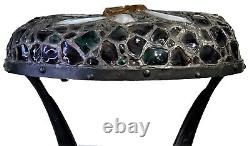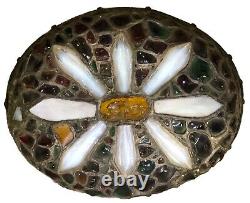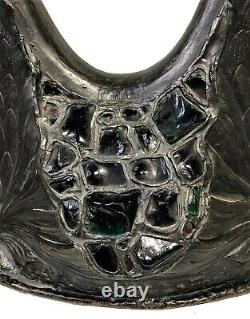Austrian Jugendstil Bronze Table Lamp with Art Glass Medallions, ca. 1900










Patinated Cast Bronze, Opaline & Art Glass Medallions. ABOUT AUSTRIAN JUGENDSTIL (ART NOUVEAU). Towards the end of the 19th century, the world of fine arts had a nicely consolidated core of conservative styles that were mostly characterized by their re-cycling of artistic developments from preceding centuries. The reactionary Austrian-Hungarian Empire with its deeply conservative Emperor Franz Joseph I and a cultural spearhead dominated by the Catholic church was heavily stuck in the age of "historicism".
Aside of impressionism, naturalism and later expressionism, Art Nouveau was one of the most important anti-historicist movement in fine arts of the late 19th and early 20th century. Characteristics are a break with traditional styles, motives taken from youth, nature and foreign cultures, a tendency to light ornaments, a two-dimensional style in painting, asymmetry, and - especially later on - a steady extension of the "object of art" to print, objects of daily use, books, jewelry, architecture, apparel design, furniture and all kinds of other things. Art was to be liberated from the canvas.
Later one branch of Art Nouveau became particularly floral and commercial - at which point many of the early Art Nouveau artists had already developed further on, to Art Deco, for example, or they had become modern classicists. Art Nouveau had several centres all over Europe. Paris and the rest of France, the Benelux countries, Scotland, Barcelona and several places in Central Europe. These include in particular the three "show case cities" of the Austrian-Hungarian Empire: Prague, Budapest and Vienna. Here Art Nouveau was called "Jugendstil" ("Style of the Youth") or.Since Vienna was the over-all capital, is also had the highest density of conservative nobility. This is certainly part of the reason why it had a hard time getting started properly. However, once a bunch of young artists had split with a lot of Austrian pomp and circumstance, Jugendstil finally kicked in and there are several places where you can follow the traces of this era in Vienna.
We guarantee the authenticity of all items to be as represented. Ashville Fine Arts Gallery specializes in a variety of fine art, antiques, jewelry, collectibles and rare finds. If you have not seen something that interests you or that you collect, please visit often and check our ever-expanding inventory. We make a best effort to provide a fair and descriptive condition report. Please examine the photos attentively, as they are an integral part of item descriptions.
Domestic & International Customers are Welcome! All items are carefully packed and insured. Please send us a message.

